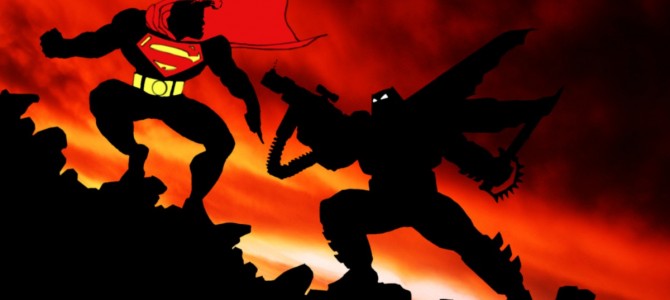
With today’s release of the “final” chapter of Frank Miller’s critically lauded comics, “The Dark Knight Returns,” it’s worth taking a look back at the previous two series: The earlier “The Dark Knight Returns” and “The Dark Knight Strikes Again” before delving into “The Dark Knight III: The Master Race.”
First, some history. “The Dark Knight Returns” stands as something of an anomaly in the medium. It was part of a deal Miller made with DC Comics after he finished his character-defining run on Daredevil for Marvel. The first book Miller produced at DC was “Ronin,” which was really the first “creator-owned” book, in both a business and storytelling respect.
The book was revolutionary. You can see similar deals happening in movies today. Christopher Nolan’s films used Miller’s work to inform his take on Batman in his own Dark Knight trilogy, and followed the “one for the studio one for me mantra” which gave us his film “Inception.”
Miller’s deal was different. He did his one for me, “Ronin,” first and in it you can see Frank exploring the themes and techniques, such as the 16-panel grid, that he would later employ in “The Dark Knight Returns.”
By the time Miller began his work on “The Dark Knight Returns,” he was a markedly different artist from the one who had previously redefined Daredevil with heavy overtones of classic noir and overwhelming Catholic guilt.
The Individual Versus the State
Miller’s Batman occupies a world that is in stark contrast to the one that his Daredevil occupied. No longer does the vigilante operate with the help of law enforcement; here, the vigilante is cast in stark contrast to it, and its multitude of failings. Here, the state and authority structures are the enemy.
Batman is cast as a force for individualism: when Gotham is burning, neighbors put out the fires and Batman leads a force to self-police those who’d take advantage. Superman is cast as the ultimate expression of the state—pure, unthinking power—and their conflict that caps off the first book of the trilogy is a battle between individual and state rendered in a four-color punchup.
“The Dark Knight Returns” was, and still is, the most notable of the Batman/Superman fights that have occurred over the years. It’s been often imitated, and Zack Snyder will be releasing his rendition of it soon, but it’s because of the underlying themes that Miller presents, the ideologies that he assigns each of these characters, that makes their showdown at the end work. It’s more than just pitting man against Superman—there are ideas at stake.
The Evolution of Dark Knight Art
Between 2001 and 2002 the follow-up, “The Dark Knight Strikes Again,” was published. Its original reception was, to put it mildly, harsh. Miller’s art had changed rather drastically since Returns and some said it marked a severe devolution. Lynn Varley, the colorist from “The Dark Knight Returns” and “Ronin,” had discovered Photoshop in the years between 1986 and 2001, and this did not serve her well. The work included weird Photoshop filters and bizarre effects choices. The comic is clearly part of the time when people were still figuring out how to deal with the massive toolbox digital gave artists.
The other member of the original Returns team, Klaus Janson, who had inked Miller’s work for “Daredevil” and “The Dark Knight Returns,” hadn’t worked with Miller since then. It’s quite clear that Janson had a massive effect on Miller’s artwork, and there’s a reason why he’s widely regarded as one of, if not the, best inker in the business (no, inkers are not tracers). The artistic shake-up ended up being a hurdle that many readers could never get over.
The book deserves reading, though, and it’s actually held up rather well. The art, in spite of some glaringly odd Photoshop choices, works. The characters are all rendered in this larger-than-life cartooning, where everything about it is simplified down to the basics. It’s the superhero adaptation of the style Miller eventually landed on with “Sin City: Hell and Back.” It’s also worth noting that Miller had begun the book before 9/11, and the effect that 9/11 had on him most assuredly changed the eventual trajectory of the book.
One Man Saves the Superheroes
In “Strikes Again,” the state has gone from a more neo-con-esque expression to full-on thought police. The president is a hologram whose settings are tweaked after message testing, and he’s run by a gross, liver-spotted version of Lex Luthor. Mass data surveillance and edited news feeds keep the population in check, and the traditional superheroes have become shadows. They’re no longer individuals with power or agency, they’re tools of Luthor, held in check by various forms of threats and blackmail.
Enter the Batman, at a time when a series of government agencies restrain the world, The Flash is held in captivity providing “free” energy to the masses, The Atom is locked in a petri dish, and Superman, Wonder Woman, and Captain Marvel have all become unwilling agents of Luthor, with varying members of each superhero’s family held at a gunpoint.
The book begins with a series of heists to save captured heroes. It culminates in another Batman/Superman showdown, this time to show that Batman is not alone: he has a team of other aging superheroes, reformed members of what once was the Mutant Gang from Returns, led by Carrie Kelley (the new Robin as seen in “The Dark Knight”). The former Gang members now all have identities and names and, more importantly, the Batman gives them a true purpose, and Carrie provides the discipline.
It is when Metropolis is destroyed by classic Superman foe Brainiac that the effects of 9/11 show. It draws on the fear, the utter terror that was unleashed that day. Miller lays it out on the page. His style heightens it, the emotional sequence works, and when Superman digs through the rubble only to find Lois Lane’s locket, it’s crushing.
A Lens Through Which to Consider Power, Good, and Evil
This is where the book turns from the direction it may have been on. Batman recruits Superman and provides him the leverage and the means to finally free himself from the control of the state, from the grip of Luthor and Brainiac. Batman, this mere mortal, saves the all-powerful Superman and the last remaining Kyptonians from the death-trap that Luthor and Brainiac have them in.
In the end, Batman, with the aid of his allies, sees to the death of Luthor and the dismantling of his security state, and ultimately frees the population. Then it ends. Batman has no inclination to take over—he’s not interested in controlling people. The members of his group are drafted, but they’re willing participants in his cause. Miller’s Batman is no dictator, and this closing chapter of “The Dark Knight Returns” picks up in this world.
The New Fight
“The Dark Knight III: The Master Race” picks up seemingly a year or two after the events of the previous chapter. Miller co-wrote the book with Brian Azzarello; it has art by Andy Kubert with inks by Janson and colors by Brad Anderson. The difference is noticeable.
The linework is excellent. Andy and Klaus make a really solid team, though it is missing the gritty, dirty quality of Miller’s art. My only artist complaint involves the colors, which are extremely sterile. They lack the character of Lynn’s work in the original and even though Strikes Again featured some odd Photoshop choices, the work here just feels like “house style,” lacking the character that a work of this level of anticipation deserves (no, I don’t think I could have done better).
On a whole, the layouts, 16-panel grid returns, pacing, and general style do a nice job reflecting Miller’s work in the previous two, so while it’s a shame he isn’t drawing it himself, the book generally looks a part of the whole.
Due to the truncated length, DC is releasing this as a series of regular-length issues (the main story runs 29 pages). The book doesn’t get going too much, and generally spends its time reintroducing characters. Without divulging any spoilers, it’s a well-done follow up that continues the running commentary on the media, lightly skewering the punditry. One line sticks out in particular: “How did we let our distractions become our focus? When did we stop thinking? Why did you come back to this?” The youth of the world now have their dialogue shown as text message windows, and Gotham police are back to being corrupt.
The Miller-drawn short that serves as epilogue actually doles out some clues to where this may be going—but saying too much would spoil it. It’s nice to see Frank doing sequential art again, and his work looks more “mainstream” than it has in a while.
Overall, though, there’s just not enough here to make a great judgement of where it’s going and what to expect, nor is there enough outside a few twists to actually dissect and discuss. Adding Azzarello has softened the bite of Miller’s writing—it lacks the high level of narration that usually define Miller’s work and it drops the rhythm of Miller’s usual dialogue. This first issue feels more like other people playing with the tropes Miller created rather than actually feeling like it’s by his hand. This isn’t particularly a letdown, but perhaps the book would have been better served if it were released in longer installments.
If you’ve never read “The Dark Knight Returns” or its follow-up, “The Dark Knight Strikes Again,” they’re both examples of the best of the medium. If reading comics isn’t your thing, “The Dark Knight Returns” is available as an animated feature (it’s a pretty strong PG-13), and while it drops much of the narration that defines the book, it’s a well-done adaptation that gets more right than not. “The Dark Knight III: The Master Race” is a well-produced follow-up, but it’s currently a pale imitation of its predecessors and shouldn’t be read as an introduction to Miller’s work.









